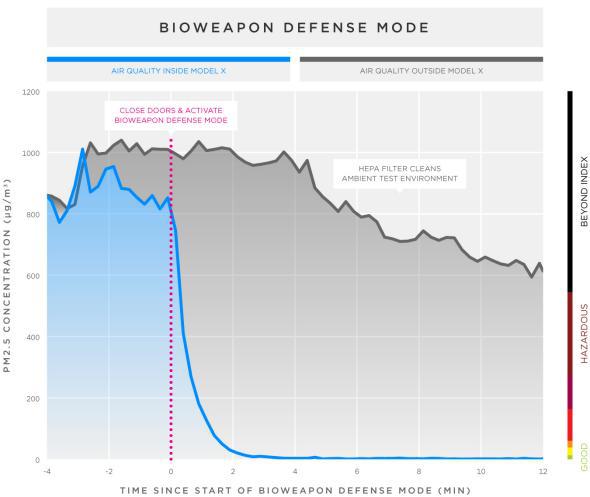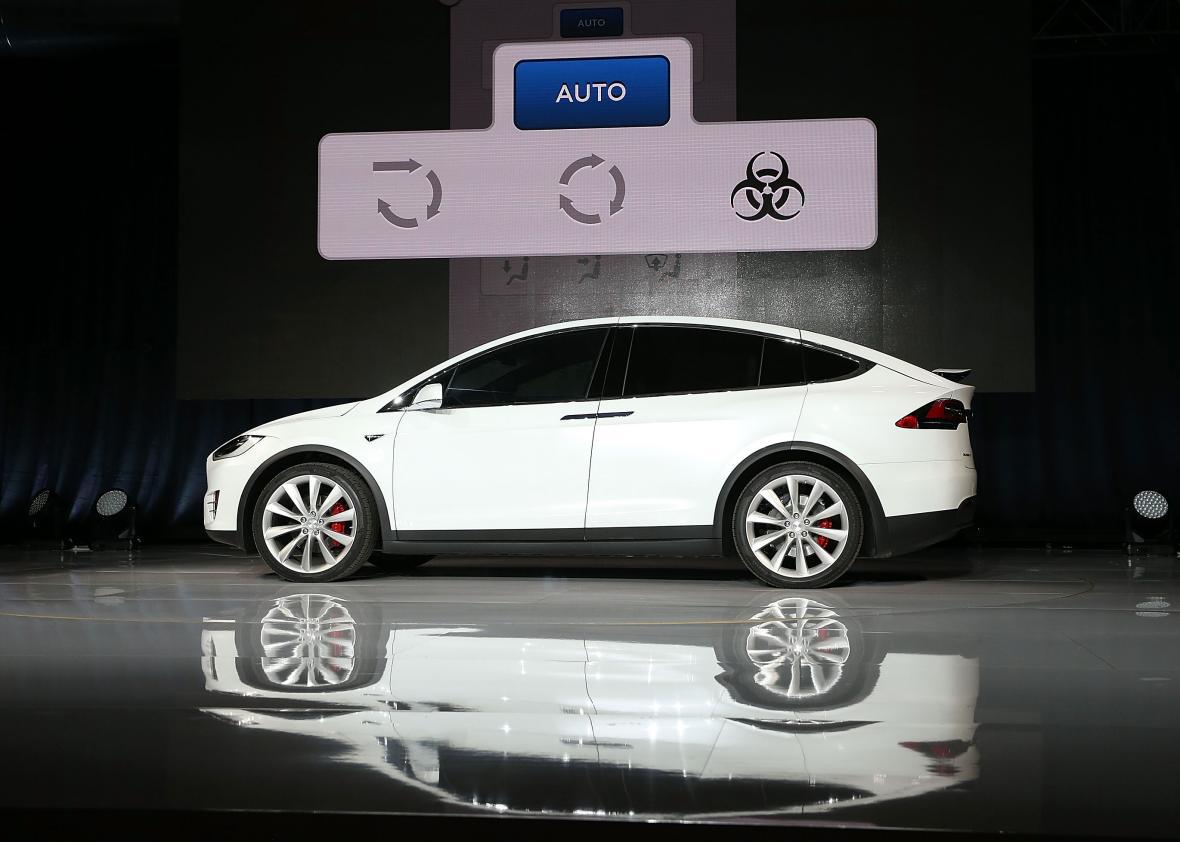When Elon Musk announced last fall that Tesla’s new Model X SUV would come with a feature called “bioweapon defense mode,” people weren’t sure whether he was joking. It sounded like just the latest, and possibly craziest, in a long line of Hollywood-inspired marketing gimmicks by the sci-fi-loving CEO. (Think of the volume controls that go to 11, Spinal Tap style, and the Spaceballs-esque “ludicrous mode” on the Model S.)
But Musk wasn’t joking. And, far from being the Model X’s “most ridiculous feature,” as one tech blog dubbed it, bioweapon defense mode could end up being one of its biggest selling points in at least one key market: China.
It isn’t that drivers in China are paranoid about bioterror attacks. It’s that many of them deal on a daily basis with oppressive air pollution, a major quality-of-life issue in some of the country’s largest cities. For China’s wealthy, the Model X may offer a haven from the smog that no other vehicle can match.
Bioweapon defense mode, it turns out, is a bit of a misnomer. I mean, sure, you’d probably turn it on if you happened to be out for a drive when someone dropped a ricin bomb nearby. But the real purpose of Tesla’s hospital-grade HEPA cabin filtration system is to protect drivers from the more quotidian menace of pervasive air pollution.
In a blog post this week, Tesla presented the results of a dramatic test designed to demonstrate just how effective the system can be. The company says it had already fared well on California highways at rush hour and in major Chinese cities. So it took things a step further:
A Model X was placed in a large bubble contaminated with extreme levels of pollution (1,000 µg/m3 [micrograms per cubic meter] of PM2.5 [a harmful form of fine particulate] vs. the EPA’s “good” air quality index limit of 12 µg/m3). We then closed the falcon doors and activated Bioweapon Defense Mode.
The chart below shows what happened next:

Illustration courtesy of Tesla Motors
Within two minutes, Tesla says, the system had scrubbed the pollution in the vehicle’s cabin to the point that it was no longer detectable by the company’s sensors. The Model X’s passengers then removed their gas masks and breathed clean air.
“Bioweapon defense mode is not a marketing statement, it is real,” the company concluded. “You can literally survive a military grade bio attack by sitting in your car.”
Perhaps you could, although bioweapons experts are skeptical that you ever would. For one thing, as Gizmodo points out, you’re unlikely to realize there has even been a biological attack until it’s too late.
So, yes, the feature’s name is a marketing gimmick. Other luxury carmakers have installed high-tech air filters that didn’t get nearly this much attention.
But the feature itself is not. As Tesla points out, the World Health Organization calls air pollution “the world’s largest single environmental health risk,” contributing to more than 3 million deaths each year. Recent studies have put that number even higher. Either way, it’s more than twice the global death rate from auto accidents.
Obviously an $80,000 luxury SUV is not going to save the vast majority of those people, especially in a country such as China whose per-capita GDP is less than one-tenth that amount. That said, it could be a huge draw for the country’s fast-growing upper class. Tesla is counting on those Chinese consumers to help drive growth in demand for its pricey electric vehicles. You could almost think of “bioweapon defense mode” as a diplomatic euphemism for “Beijing mode.”
But Tesla was quick to point out that this isn’t just about China. “I disagree about this being a gimmick in any market,” spokeswoman Alexis Georgeson told me. “The HEPA filter is valuable anywhere with less than pristine air quality, which is a lot of places in the U.S. and the world.” She cited WHO estimates that air pollution reduces average life expectancy by 23 months in Beijing, but also by 10 months in Mexico City, nine months in Hong Kong, eight in Berlin and Los Angeles, and seven in Paris and London. “Not to mention this is incredibly valuable for those suffering from (or who have children suffering from) asthma and allergies.”
Even if it didn’t save or extend drivers’ lives, the system would still hold appeal as a luxury feature, blocking out unpleasant smells when you drive past a landfill or a skunk, or pretty much anywhere in California’s dung-filled Central Valley. Here’s a Tesla driver testing it out while driving through a polluted stretch of highway in Arizona.
Granted, the video was made by a self-professed Tesla lover who won his Model X in a Tesla-sponsored referral contest. I hope to get a better idea of how well the feature works when I test-drive a Model X in the coming weeks.
Regardless, the feature looks like another ingenious marketing maneuver by Musk—one that has a surprisingly serious purpose. And yes, when you turn it on, the fans go to 11.
